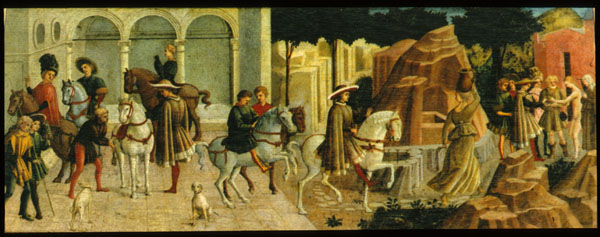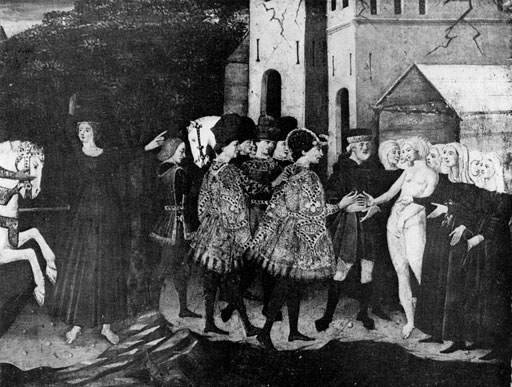Illustrations of the Griselda novella: Introduction
Griselda is a complicated story (X.10) not only because it, like so many Decameron tales affords multiples interpretations, but also due to the contrastingly sacred and secular roots and progeny of this story's involvement in the history of european literature. The testings of Griselda's loyalty have their source in the biblical trials of Job. While, the great humanist Petrarch devoted himself unsollicited to the translation of Boccaccio's vernacular version into Latin, with substantial revision or "redressing" of content and meaning. It has also been noted that the Griselda theme was prevalent in popular forms of entertainment and low forms of literature throughout the Renaissance in such examples as: Giovanni Sercambi's inclusion of Griselda, in the form of a character named Constantina, in his Novelle, Chaucer's appropriation of the story in Canterbury tales, and the fifteenth century production of a Griselda Play, assumed to be a sort of secularized Sacra rappresentazione, in Florence.)
Pesellino's Griselda I and II
Two panels attributed to Pesellino, dated to ca. 1450, are currently held in the collection of the Accademia Carrara in Bergamo. The first panel is titled Gualtieri and Advisors, and depicts an interior of the Marquis de Saluzzo's castle. Gualtieri himself is seated on a raised dais, surrounded by his subjects, and the entire figure grouping is framed by Brunelleschian arches. The architectural framing securely anchors the image, while the formal composition of the panel suggests an atmosphere of reason and order, despite the textual subject matter of a heated debate over Gualtieri's bachelor status.
 Cassone panel showing Gualtieri's departure to meet Griselda, Accademia Carrara, Bergamo
Cassone panel showing Gualtieri's departure to meet Griselda, Accademia Carrara, Bergamo
The second panel, above, is titled The Story of Griselda, and depicts three distinct stages of activity between the first panel and the scene in which Griselda is stripped nude before becoming Gualtieri's bride. Pesellino, here again, depends upon the architectural or environmental frame of the setting to determine visual ambience and create convincing transitional space. The three Gualtieri figures in this painting, as the narrative flows from left to right, pass through an aristocratic architectural setting, demarcated by the geometrical floor patterning and continued columns and arches, into a mountainous, rural space through which a stream flows, finally concluding amidst the peasant cottages of the campagna. The treatment of transitional narrative space in this image is handling in an interesting way when compared with the Apollonio di Giovanni mentioned below. While the Apollonio di Giovanni image encorporates more action, the rigid frontal positioning of the figures creates a far more static composition, that is more difficult to read as a narrative progression. Pesellino on the otherhand, utilizes dynamic poses and places his characters in spatial relations that flow easily to the right while maintaining enough leftward tension for the image to allow slow purusal. Baskins has suggested that this urban/rural or culture/nature dichotymy is representative of the male/female power dynamic in patriarchal society.
Apollonio di Giovanni's Story of Griselda
 Detail of a cassone panel by Apollonio di Giovanni depicting Griselda's marriage
Detail of a cassone panel by Apollonio di Giovanni depicting Griselda's marriage
This cassone panel by Apollonio di Giovanni was executed ca. 1460 and is currently in the holdings of the Galleria Estense in Modena. It depicts only the first half of Boccaccio's version of the Story of Griselda, and was probably originally the frontal panel of a cassone which could have been concluded by pendants that flanked the chest. The panel that does remain from the incomplete series also mimics narrative flow by representing multiple temporal moments in the same image. Apollonio di Giovanni paints the same figures engaged in different activities, progressing from the left edge to the right. This casssone panel is out of the ordinary in that it is able to encompass four separate narrative moments in just one visualization, and Gualtieri, the Marquis of Saluzzo, shows up four times in all. First, he is represented at left, deep in consultation with his advisors and subjects who desire that he should take a wife. Next, he is seen hesitating on the front step of his castle still unsure of seeking out a mate. Only three quarters of the way across the panel does Griselda herself show up, in her very first meeting with her husband to be. She is tall and corporeally substantial, with a water jug balanced overhead, as she directs her "lord" to her father's home. The fourth and last moment of this sequential image deals with the moment in which Gualtieri claims his new bride by having her stripped naked and redressed as befit a noble woman.
The sequence of images progresses relatively fluidly until Griselda shows up in the third framed moment within the image. She towers, columnar, over Gualtieri and her hand up over her head to support the water vase she supports there acts as an even more effective barrier against visual or physical passage to the right side of the painting. Griselda is visualized as a veritable stumbling block, which Gualtieri must forcibly overcome. He does this in the fourth segment by publicly divesting her of material protection and rewrapping her in his own material possessions. Griselda's stature shrinks measurably from the third to the fourth moment of the painting, and her nude body describes fluid curvilinear forms which, though she leans away from her groom hesitantly, afford non of the rigid resistance she exhibited in the third section of the image. This image particularly prefigures the later contests contests of domination that Gualtieri forces Griselda to suffer.
For a more thorough analysis of the Griselda theme, especially as it is represented on the panels of Pesellino and Apollonio, refer to Cristelle Baskins' theories in the review of her article, "Griselda, or The Renaissance Bride Stripped Bare by Her Bachelor in Tuscan Cassone Painting".
Bibliography: Baskins, Cristelle L. "Griselda, or The Renaissance Bride Stripped Bare by Her Bachelor in Tuscan Cassone Painting", Stanford Italian Review X:2 (1991): 153-175; Watson, Paul F. "A Preliminary List of Subjects from Bocaccio in Italian Painting, 1400-1550" Studi sul Boccaccio, Firenze: Sansoni Editore, 1985-6, 15, p. 149-166.
(S.A.)